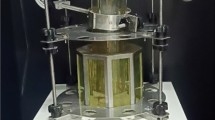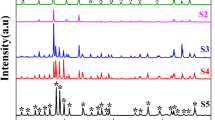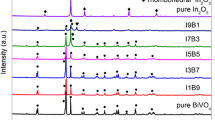Abstract
The heterojunction composites (Ba0.85Ca0.15)(Zr0.1Ti0.9)TiO3(BCZT)/Bi2O3 with different weight ratios (75:25, 50:50 and 25:75) were successfully synthesized by solid-state route. As-synthesized composite powders were characterized by XRD, FESEM, EDX, UV–visible and photoluminescence spectroscopy. Photocatalytic activity evaluation was carried out by the degradation of rhodamine B (RhB) under UV and visible light exposure. The results show that the heterojunction composites BCZT/Bi2O3 display better photocatalytic activity than pure BCZT or Bi2O3. Among all the heterojunction composites, BCZT/Bi2O3 (50:50) composite exhibits a lower recombination rate of electron–hole pair and shows the highest photocatalytic activity. The rate constant of BCZT/Bi2O3 (50:50) composite for RhB degradation is 15.4 and 2.1 times higher than those of pure BCZT and Bi2O3 under visible light irradiation, respectively. Finally, a possible mechanism for enhanced charge separation and photodegradation is proposed.










Similar content being viewed by others
References
Gaya UI, Abdullah AH (2008) Heterogeneous photocatalytic degradation of organic contaminants over titanium dioxide: a review of fundamentals, progress and problems. J Photochem Photobiol C Photochem Rev 9:1–12
Boppella R, Anjaneyulu K, Basak P, Manorama SV (2013) Facile synthesis of face oriented ZnO crystals: tunable polar facets and shape induced enhanced photocatalytic performance. J Phys Chem C 117:4597–4605
Shakir I, Shahid M, Kang DJ (2013) Highly functional SnO2 coated PZT core-shell heterostructures as a visible light photocatalyst for efficient water remediation. Chem Eng J 225:650–655
Wang H, Zhang L, Chen Z et al (2014) Semiconductor heterojunction photocatalysts: design, construction, and photocatalytic performances. Chem Soc Rev 43:5234–5244
Wu Q, Li D, Wu L et al (2006) Unprecedented application of lead zirconate titanate in degradation of Rhodamine B under visible light irradiation. J Mater Chem 16:1116–1117
Huang H, Li D, Lin Q et al (2009) Efficient photocatalytic activity of PZT/TiO2 heterojunction under visible light irradiation. J Phys Chem C 113:14264–14269
Cui Y, Briscoe J, Dunn S (2013) Effect of ferroelectricity on solar-light-driven photocatalytic activity of BaTiO3—Influence on the carrier separation and stern layer formation. Chem Mater 25:4215–4223
Xiong X, Li S, Tian R et al (2015) Formation and photocatalytic activity of BaTiO3 nanocubes via hydrothermal process. J Nanomater 2015:1–6
Kappadan S, Woldu T, Thomas S, Kalarikkal N (2016) Materials science in semiconductor processing tetragonal BaTiO3 nanoparticles: an efficient photocatalyst for the degradation of organic pollutants. Mater Sci Semicond Process 51:42–47
Kaya C, Kalem V, Teber S (2018) Photocatalytic activity and dielectric properties of hydrothermally derived tetragonal BaTiO3 nanoparticles using TiO2 nano fibers. J Alloys Compd 765:82–91
Fu Q, Wang X, Li C et al (2016) Enhanced photocatalytic activity on polarized ferroelectric KNbO3. RSC Adv 6:108883–108887
Tonda S, Santosh Kumar OA, Shanker V (2014) Synthesis of Cr and La-codoped SrTiO 3 nanoparticles for enhanced photocatalytic performance under sunlight irradiation. Phys Chem Chem Phys 16:23819–23828
Yang SY, Seidel J, Byrnes SJ et al (2010) Above-bandgap voltages from ferroelectric photovoltaic devices. Nat Nanotechnol 5:143–147
Morris MR, Pendlebury SR, Hong J et al (2016) Effect of internal electric fields on charge carrier dynamics in a ferroelectric material for solar energy conversion. Adv Mater 28:7123–7128
Li L, Salvador PA, Rohrer GS (2014) Photocatalysts with internal electric fields. Nanoscale 6:24–42
Zhao X, Liu H, Qu J (2011) Photoelectrocatalytic degradation of organic contaminants at Bi2O3/TiO2 nanotube array electrode. Appl Surf Sci 257:4621–4624
Lin X, Xing J, Wang W et al (2007) Photocatalytic activities of heterojunction semiconductors Bi2O3/BaTiO3: a strategy for the design of efficient combined photocatalysts. J Phys Chem C 111:18288–18293
Ye X, Zhao S, Meng S et al (2017) Remarkable enhancement of photocatalytic performance via constructing a novel Z-scheme KNbO3/Bi2O3 hybrid material. Mater Res Bull 94:352–360
Fan H, Li H, Liu B et al (2012) Photoinduced charge transfer properties and photocatalytic activity in Bi2O3/BaTiO3 composite photocatalyst. ACS Appl Mater Interfaces 4:4853–4857
Chu S, Kong F, Wu G et al (2011) Architecture of Cu2O@TiO2 core-shell heterojunction and photodegradation for 4-nitrophenol under simulated sunlight irradiation. Mater Chem Phys 129:1184–1188
Zhou W, Liu H, Wang J et al (2010) Ag2O/TiO2 nanobelts heterostructure with enhanced ultraviolet and visible photocatalytic activity. ACS Appl Mater Interfaces 2:2385–2392
Cui Y, Briscoe J, Wang Y et al (2017) Enhanced photocatalytic activity of heterostructured ferroelectric BaTiO3/α-Fe2O3 and the significance of interface morphology control. ACS Appl Mater Interfaces 9:24518–24526
Jiang HY, Cheng K, Lin J (2012) Crystalline metallic Au nanoparticle-loaded α-Bi2O3 microrods for improved photocatalysis. Phys Chem Chem Phys 14:12114–12121
Liu W, Ren X (2009) Large piezoelectric effect in Pb-free ceramics. Phys Rev Lett 103:1–4
Abhinay S, Mazumder R, Seal A, Sen A (2016) Tape casting and electrical characterization of 0.5Ba(Zr0.2Ti0.8)O3–0.5(Ba0.7Ca0.3)TiO3 (BZT–0.5BCT) piezoelectric substrate. J Eur Ceram Soc 36:3125–3137
Adhikari P, Mazumder R, Abhinay S (2016) Electrical and mechanical properties of MgO added 0.5Ba(Zr0.2Ti0.8)O3–0.5(Ba0.7Ca0.3)TiO3 (BZT–0.5BCT) composite ceramics. J Electroceram 37:127–136
Raja S, Ramesh Babu R, Ramamurthi K, Moorthy Babu S (2018) Room temperature ferromagnetic behavior, linear and nonlinear optical properties of KNbO3 microrods. Ceram Int 44:3297–3306
Andrade GRS, Nascimento CC, Silva Júnior EC et al (2017) ZnO/Au nanocatalysts for enhanced decolorization of an azo dye under solar, UV-A and dark conditions. J Alloys Compd 710:557–566
Wei K, Wang B, Hu J et al (2019) Photocatalytic properties of a new Z-scheme system BaTiO3/In2S3 with a core-shell structure. RSC Adv 9:11377–11384
Xu Q, Zhang L, Yu J et al (2018) Direct Z-scheme photocatalysts: principles, synthesis, and applications. Mater Today 21:1042–1063
You-Ji L, Wei C (2011) Photocatalytic degradation of Rhodamine B using nanocrystalline TiO2-zeolite surface composite catalysts: effects of photocatalytic condition on degradation efficiency. Catal Sci Technol 1:802–809
Tabit R, Amadine O, Essamlali Y et al (2018) Magnetic CoFe2O4 nanoparticles supported on graphene oxide (CoFe2O4/GO) with high catalytic activity for peroxymonosulfate activation and degradation of rhodamine B. RSC Adv 8:1351–1360
Natarajan TS, Thomas M, Natarajan K et al (2011) Study on UV-LED/TiO2 process for degradation of Rhodamine B dye. Chem Eng J 169:126–134
Acknowledgements
We are thankful to the Director, NIT Rourkela, Odisha, India, for providing experimental facilities.
Author information
Authors and Affiliations
Corresponding author
Ethics declarations
Conflict of interest
The authors declare no conflict of interest.
Additional information
Publisher's Note
Springer Nature remains neutral with regard to jurisdictional claims in published maps and institutional affiliations.
Rights and permissions
About this article
Cite this article
Abhinay, S., Tarai, P. & Mazumder, R. Preparation and characterization of (Ba0.85Ca0.15)(Zr0.1Ti0.9)TiO3(BCZT)/Bi2O3 composites as efficient visible-light-responsive photocatalysts. J Mater Sci 55, 1904–1914 (2020). https://doi.org/10.1007/s10853-019-04175-3
Received:
Accepted:
Published:
Issue Date:
DOI: https://doi.org/10.1007/s10853-019-04175-3




